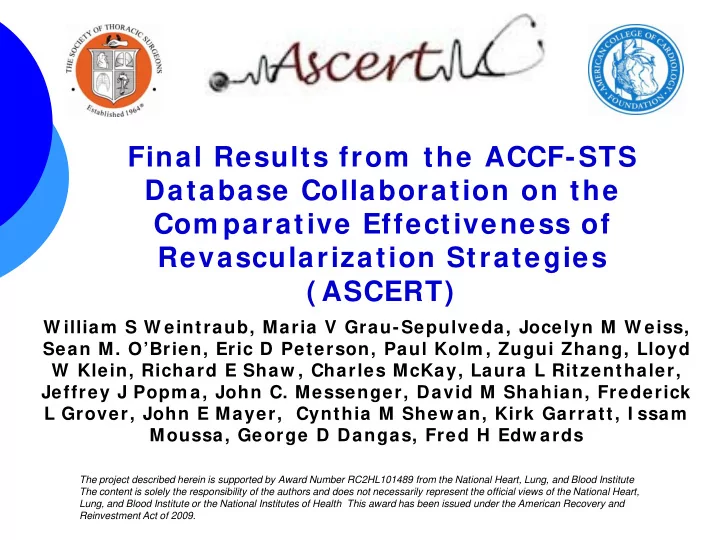

Final Results from the ACCF-STS Database Collaboration on the Com parative Effectiveness of Revascularization Strategies ( ASCERT) W illiam S W eintraub, Maria V Grau-Sepulveda, Jocelyn M W eiss, Sean M. O’Brien, Eric D Peterson, Paul Kolm , Zugui Zhang, Lloyd W Klein, Richard E Shaw , Charles McKay, Laura L Ritzenthaler, Jeffrey J Popm a, John C. Messenger, David M Shahian, Frederick L Grover, John E Mayer, Cynthia M Shew an, Kirk Garratt, I ssam Moussa, George D Dangas, Fred H Edw ards The project described herein is supported by Award Number RC2HL101489 from the National Heart, Lung, and Blood Institute The content is solely the responsibility of the authors and does not necessarily represent the official views of the National Heart, Lung, and Blood Institute or the National Institutes of Health This award has been issued under the American Recovery and Reinvestment Act of 2009.
Conflicts of Interest • Dr. Dangas reports receiving consulting fees from Abbott Vascular, Astra Zeneca, Eli Lilly, Johnson & Johnson, and Ogilvy, receiving grant support from Bristol-Myers Squibb, Eli Lilly, Daichi-Sankyo, Medicines Co., and Sanofi- Aventis, lecture fees from Abbott Vascular, AstraZeneca, Boston Scientific, Bracco, Bristol-Myers Squibb, Guerbet, Eli Lilly, Johnson & Johnson, the Medicines Co., and Sanofi-Aventis, royalties from Wiley and Informa, and travel support from the Cardiovascular Research Foundation • Dr. Edwards, being an employee of the Society of Thoracic Surgeons • Dr. Mayer, receiving honorarium and travel support from CHMC Cardiovascular Surgical Foundation • Dr. Messenger, receiving grant support from the Medtronic Corporation • Dr. Popma, receiving consulting fees from Abbott Vascular, Boston Scientific, and Covidien, and grant support from Abbott Vascular, Abiomed, Boston Scientific, Cordis, and Medtronic
Source of Funding • Award Number RC2HL101489 from the National Heart, Lung, and Blood Institute
Data from 644 Sites NCDR Sites STS Sites
Purpose • To compare long-term mortality of coronary artery bypass surgery and percutaneous coronary intervention
Meta-Analysis of 10 Trials, 7812 Patients HR 0·91 (0·82–1·02), p= 0·12 HR 0·97 (0·88–1·06), p= 0·47 Age < 55 years 1·25 (0·94–1·66) Age 55–64 years 0·90 (0·75–1·09) Age > 65 years 0·82 (0·70–0·97) Interaction P= 0.002 Hlatky et al, Lancet 2009; 373: 1190–97
NY State Database Observational Study,17,400 Patients Hannan et al, N Engl J Med 2008; 358: 331-41.
Statistical Methods • Patients from NCDR CathPCI and STS Registries from 2004- 2007, followed until end 2008 • Each linked to CMS 100% denominator file linked by probabilistic matching, using admit date, discharge date, race, sex, age • Propensity for CABG determined for all patients by logistic regression • Patients differences brought into balance by inverse probability weighting, allowing comparisons of groups • Sensitivity analysis with propensity matched, Cox model and double robust methods • Sensitivity analysis for possible unmeasured confounders by the method of Lin et al
Sources of Data • PCI: NCDR CathPCI Registry • CABG: STS Registry • Long term followup: CMS 100% denominator file
Baseline Data
30-Day 1-Year 2-Year 3-Year 4-Year 30-Day 1-Year 2-Year 3-Year 4-Year 2.07% 6.00% 8.76% 12.1% 16.0% 2.25% 6.24% 8.98% 12.4% 16.4% CABG (1.98-2.17) (5.58-6.17) (8.56-8.94 (11.9-12.4) (15.7-16.3) (2.09-2.41) (5.97-6.50) (8.68-9.29) (12.0-12.8) (15.9-16.9) mortality 1.21% 6.36% 11.2% 16.0% 20.9% 1.31% 6.55% 11.3% 15.9% 20.8% PCI (1.14-1.27) (6.22-6.51) (11.0-11.4) 15.7-16.2) (20.6-21.3) (1.21-1.41) (6.35-6.76) (11.0-11.6) (15.6-16.3) (20.4-21.2) mortality 1.72 0.94 0.78 0.76 0.76 1.72 0.95 0.79 0.78 0.79 Relative (1.58-1.84) (0.91-0.97) (0.76-0.80) (0.74-0.78) (0.75-0.78) (1.52-1.89) (0.90-1.00) (0.76-0.83) (0.75-0.81) (0.76-0.82) Risk
Baseline Data
0 % 1 0 % 2 0 % 3 0 % 4 0 % 5 0 % 6 0 % 7 0 % 8 0 % 9 0 % 1 0 0 %
Limitations • All observational studies have possible treatment selection bias • This can be approached, but not fully resolved, by careful database design, statistical analysis and sensitivity analysis • Several variables were not available (e.g. frailty) or of limited quality (e.g. angiographic details) in the ASCERT data • There was missing data for several variables (e.g. GFR and EF) • ASCERT outcomes are limited to patients age 65 and older • This presentation concerns mortality only (composite endpoints, angiographic analyses, economic analysis will follow)
Comparative Effectiveness Research Implications of ASCERT • Observational studies can provide real-world outcomes with greater generalizability than randomized trials • Linking robust clinical databases with administrative database capitalizes on the advantages of both • This allows for very large studies with power to examine subgroups • Administrative databases can also supplement clinical databases with resource use/ cost data • There are also limitations to observational studies • For comparative effectiveness to reach is potential, randomized trials and observational studies will both have critical roles to play
Conclusions • Survival was similar in the two arms at 1 years • Survival was higher in the CABG than PCI arm at 4 years • The results were largely consistent across subgroups • This is largely consistent with both clinical trial and observational studies • Causal inference requires considering the totality of the data, of which ASCERT is a critical part • ASCERT offers critical experience in comparative effectiveness research using observational data
Recommend
More recommend